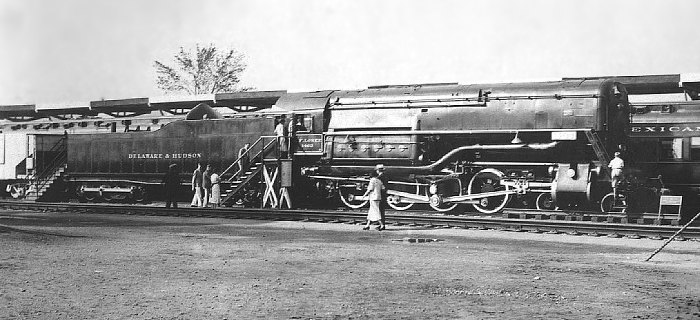One of the most fascinating rail exhibits photographed by the Wickhams at the Century of Progress was the Delaware & Hudson's No. 1403, named the L. F. Loree. This experimental locomotive, built in the railroad's Colonie Shops, had been placed in service in April, 1933. No. 1403 was the fourth and last in a series of high-pressure locomotives that were the brainchild of the railroad's president, Leonor F. Loree, whose name the locomotive bore. While the earlier engines were 2-8-0s, the Loree was of the rare 4-8-0 configuration found only on a few railroads such as the Norfolk & Western. (It was known as the "Twelve-Wheeler" type.)
The D&H claimed that the Loree was "the first four outside cylinder, triple expansion, non-articulated locomotive." Both the front and rear cylinders connected to the main pair of driving wheels. The rear cylinders, however, were not paired but cross-compounded. As the railroad stated in a folder from my father's collection, "Steam is expanded in three stages, being used first in a high pressure cylinder under right side of cab [20x32], then in an intermediate cylinder under left side of cab [27½x32] and finally in two low pressure cylinders at front of locomotive [33x32], from which it exhausts through the stack." To produce the steam necessary for this triple expansion, the Loree maintained a 500-pound pressure in a combination water-tube and fire-tube boiler.
Other features of No. 1403 unusual for North American locomotives were the overfire jets on the firebox, supplying extra air for more complete fuel combustion; the auxiliary engine on the six-wheel rear tender truck; and rotary cam poppet valves, driven from a gear suspended at the center of the main driver. Overfire jets appeared on some more conventional post-World War II locomotives such as the Chesapeake & Ohio's "Allegheny" 2-6-6-6 articulateds erected by Lima Locomotive Works, and the 2-8-4s supplied to the Pittsburgh & Lake Erie in 1948 by the American Locomotive Company. Poppet valves, of European origin, were thought to be more efficient than standard valve motion such as the Baker or Walschaerts types, but they incurred higher maintenance costs. Oscillating-cam poppet valves were used on the Pennsylvania Railroad's T1 duplex 4-4-4-4s, the C&O's streamlined L-1 4-6-4s and a few other locomotives, but rotary-cam valves appeared only experimentally.
The L. F. Loree was an idea that appeared too late. With its 63-inch drivers and its high tractive effort — a total of 108,000 pounds maximum with all cylinders using fresh steam and the tender booster cut in — it was essentially a low-speed freight engine. By 1933 the cutting edge of steam locomotive design was moving in another direction, toward "superpower" high-horsepower locomotives capable of both freight and passenger service. The Delaware & Hudson itself soon abandoned Mr. Loree's penchant for experimentation and embraced the new era with its dual-service 4-8-4s and 4-6-6-4 Challengers, locomotives whose only distinctive D&H features were their recessed headlights and flanged stacks.
